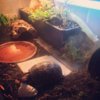Mavrik
Member
- Joined
- Oct 14, 2014
- Messages
- 81
If a plastic tote with roughly the measurements of a 50gal tank has higher sides than a standard glass 40gal tank, would the 40gal tank technically be a better option, since theoretically it would have better air flow with the lower sides?
This thought crossed my mind as I was checking on all my shellings today -- I use both a ~50gal tote for my yellowfoot Manny, and my 2 redfoots Chico and Chava are in a 40gal tank. They both have the same amount of floor space, but the 40gal tank has lower sides than the tote. I run a room humidifier with a fairly powerful fan to keep the ambient humidity up, but it seems like I have more issues with the plastic tote than I do with the glass tank.
Let's discuss!
This thought crossed my mind as I was checking on all my shellings today -- I use both a ~50gal tote for my yellowfoot Manny, and my 2 redfoots Chico and Chava are in a 40gal tank. They both have the same amount of floor space, but the 40gal tank has lower sides than the tote. I run a room humidifier with a fairly powerful fan to keep the ambient humidity up, but it seems like I have more issues with the plastic tote than I do with the glass tank.
Let's discuss!




